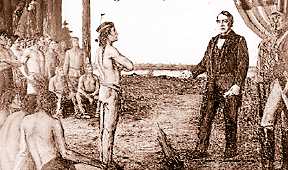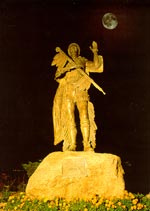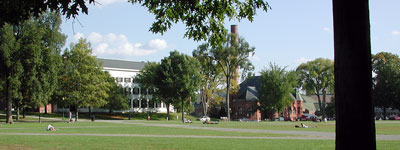|
|
Canku Ota |
|
|
(Many Paths) |
||
|
An Online Newsletter Celebrating Native America |
||
|
September 21, 2002 - Issue 70 |
||
|
|
||
|
This Date In |
||
|
North American Indian History |
||
|
from On This Date in North American Indian History at http://americanindian.net |
||
| Sept. 21, 1904: | Chief Joseph (Hinmaton-yalatkit or Hein-mot too-ya-la-kekt) dies. |
|
|
|
| Sept. 22, 1711: | The Tuscarora Indians, under Chief Hencock, join the Coree, Pamlico, Machapunga, and Bear River Indians in an attack on the white settlements on the Trent and Pamlico Rivers in North Carolina. Almost 130 white adults, and half that many children are killed. The war springs from whites settling in Indian lands, and Indian retaliations. A Swiss promoter, Baron Christoph von Graffenried orders the Indians removed, when he discovers them on lands he has obtained from the Crown, at New Bern, in western North Carolina. |
|
|
|
| Sept. 23, 1839: | The Cherokee Nation's Supreme Court is established. |
|
|
|
 Gov. Lewis Cass makes the Treaty of Saginaw with the Chippewa Indians. |
|
| Sept. 24, 1819: | Lewis Cass negotiates a treaty (7 stat. 203) for the United States with the Chippewas. For $1000 a year, the services of a blacksmith, and provisions, the Chippewa give up a large section of land. The treaty is signed in Saginaw, Michigan. |
|
|
|
| Sept. 25, 1714: | The five Iroquois Nations send the Governor of New York, a letter. They tell the Governor, that the Tuscaroras join the Iroquois Confederacy. Long ago, they had moved away. Now, they return. |
|
|
|
| Sept. 26, 1675: | Troops under Virginia Colonel John Washington and Maryland Major Thomas Trueman surround the main base of the Susquehannock Indians. They are there to discover if the Indians are responsible for attacking colonial settlements. Trueman calls out the Susquehannock for a conference under a flag of truce. Five Chiefs come out of their fortified position to talk. They deny being involved in the attacks. Trueman has them led away and killed. Trueman gets off with a minor fine from the Maryland Assembly for this act. |
|
|
|
 Red Bird Statue, at High Cliff State Park in Wisconsin, by moonlight. |
|
| Sept. 27, 1827: |
According to some historians, today marks the end of the "Winnebago Expedition." After the "Red Bird War", which started on June 29, 1827, Winnebago Chief Red Bird surrenders, in response to the army's threat to destroy the entire tribe. Red Bird is found guilty of murdering several settlers and rivermen; but, he dies in prison before he is sentenced. |
|
|
|
| Sept. 28, 1867: | In the final day of a three day fight, the First Cavalry, Twenty-Third Infantry and Boise Indian scouts, fight with a combined force of Paiute, Pit River and Modoc Indians in Infernal Canyon, near Pitt River, south of modern Alturas, California. A total of one officer, six soldiers, and one civilian are killed. Eleven soldiers are wounded. Indians losses are twenty killed, twelve wounded and two captured. |
|
|
|
| Sept. 29, 1806: |
Zebulon Pike holds a grand council with the Pawnee. Pike estimates 400 Pawnee warriors attend. He hopes to win their allegiance to the United States, rather than Spain. |
|
|
|
| Sept. 30, 1730: | In British Court in London, seven Cherokee leaders sign the "Articles of Agreement" with the Lords Commissioners. It is a formal alliance covering allegiance, peace and the return of captives. |
|
|
|
| Oct. 1, 1735: | According to some sources, an agreement covering "amity and commerce" is reached by representatives of the British in New York, and Western Abenaki, Housatonic, Mohegan and Scaghticoke Indians. |
|
|
|
 The Dartmouth Green |
|
| Oct. 2, 1792: | Mohegan Samson Occom dies in New Stockbridge, New York. A protégé of Rev. Eleazar Wheelock, Occom learns numerous foreign languages, become an ordained minister, be the first Indian to preach in England, minister to many Indian tribes, and be instrumental in the establishment of Dartmouth College in New Hampshire. |
|
|
|
| Oct. 3, 1761: | According to some records, a conference regarding land questions and the return of prisoners is held for the next ten days between representatives of the British in Pennsylvania and the Cayuga, Conoy, Delaware, Mahican, Nanticoke, Oneida and Onondaga Indians. |
|
|
|
| Oct. 4, 1742: |
According to some reports, a meeting is held between representatives of the British in Massachusetts and the Maliseet, Norridgewock, Passamaquoddy, Penobscot, Pigwacket and St. Francis Indians regarding trade problems. |
|
|
|
|
For Information on This Date in Canada visit our friends at: |
|
Canadian
Aboriginal News |
|
|
||
|
|
||
| Canku Ota is a free Newsletter celebrating Native America, its traditions and accomplishments . We do not provide subscriber or visitor names to anyone. Some articles presented in Canku Ota may contain copyright material. We have received appropriate permissions for republishing any articles. Material appearing here is distributed without profit or monetary gain to those who have expressed an interest. This is in accordance with Title 17 U.S.C. section 107. | ||
|
Canku Ota is a copyright © 2000, 2001, 2002 of Vicki Lockard and Paul Barry. |
||
|
|
|
|
|
The "Canku Ota - A Newsletter Celebrating Native America" web site and its design is the |
||
|
Copyright © 1999, 2000, 2001, 2002 of Paul C. Barry. |
||
|
All Rights Reserved. |
||
